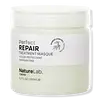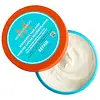What's inside
What's inside
 Key Ingredients
Key Ingredients

 Benefits
Benefits

 Concerns
Concerns

 Ingredients Side-by-side
Ingredients Side-by-side

Water
Skin ConditioningCetearyl Alcohol
EmollientDimethicone
EmollientSteartrimonium Chloride
PreservativeGlucose
HumectantPhyllostachys Pubescens Meristem Cell Lysate
Skin ConditioningArgania Spinosa Sprout Cell Extract
Skin ConditioningMalus Domestica Fruit Cell Culture Extract
Skin ConditioningVitis Vinifera Fruit Cell Extract
Skin ConditioningGlutamic Acid
HumectantSodium PCA
HumectantKeratin
Skin ConditioningHydrolyzed Keratin
HumectantPrunus Domestica Seed Extract
EmollientArgania Spinosa Kernel Oil
EmollientLupinus Albus Seed Oil
Skin ConditioningMangifera Indica Seed Oil
EmollientTheobroma Grandiflorum Seed Butter
Skin ConditioningAdansonia Digitata Seed Oil
EmollientCarapa Guaianensis Seed Oil
Skin ConditioningSclerocarya Birrea Seed Oil
HumectantOpuntia Ficus-Indica Seed Oil
EmollientIsomalt
HumectantEthylhexyl Palmitate
EmollientDipentaerythrityl Tri-Polyhydroxystearate
EmollientDimethiconol
EmollientHydrogenated Castor Oil Isostearate
Skin ConditioningDipentaerythrityl Hexahydroxystearate/Hexastearate/Hexarosinate
Skin ConditioningHydroxyethylcellulose
Emulsion StabilisingXanthan Gum
EmulsifyingLecithin
EmollientDicocodimonium Chloride
EmulsifyingCetrimonium Chloride
AntimicrobialBenzotriazolyl Dodecyl P-Cresol
UV AbsorberIsopropyl Alcohol
SolventGlycerin
HumectantTocopherol
AntioxidantEtidronic Acid
Phenoxyethanol
PreservativeSodium Benzoate
MaskingParfum
MaskingCI 19140
Cosmetic ColorantCI 42090
Cosmetic ColorantCI 17200
Cosmetic ColorantWater, Cetearyl Alcohol, Dimethicone, Steartrimonium Chloride, Glucose, Phyllostachys Pubescens Meristem Cell Lysate, Argania Spinosa Sprout Cell Extract, Malus Domestica Fruit Cell Culture Extract, Vitis Vinifera Fruit Cell Extract, Glutamic Acid, Sodium PCA, Keratin, Hydrolyzed Keratin, Prunus Domestica Seed Extract, Argania Spinosa Kernel Oil, Lupinus Albus Seed Oil, Mangifera Indica Seed Oil, Theobroma Grandiflorum Seed Butter, Adansonia Digitata Seed Oil, Carapa Guaianensis Seed Oil, Sclerocarya Birrea Seed Oil, Opuntia Ficus-Indica Seed Oil, Isomalt, Ethylhexyl Palmitate, Dipentaerythrityl Tri-Polyhydroxystearate, Dimethiconol, Hydrogenated Castor Oil Isostearate, Dipentaerythrityl Hexahydroxystearate/Hexastearate/Hexarosinate, Hydroxyethylcellulose, Xanthan Gum, Lecithin, Dicocodimonium Chloride, Cetrimonium Chloride, Benzotriazolyl Dodecyl P-Cresol, Isopropyl Alcohol, Glycerin, Tocopherol, Etidronic Acid, Phenoxyethanol, Sodium Benzoate, Parfum, CI 19140, CI 42090, CI 17200
Water
Skin ConditioningCetearyl Alcohol
EmollientBehentrimonium Chloride
PreservativeCanola Oil
EmollientButyrospermum Parkii Butter
Skin ConditioningParfum
MaskingDimethicone
EmollientArgania Spinosa Kernel Oil
EmollientCaryocar Brasiliense Fruit Oil
Skin ConditioningHydrolyzed Vegetable Protein Pg-Propyl Silanetriol
Skin ConditioningGuar Hydroxypropyltrimonium Chloride
Skin ConditioningTocopherol
AntioxidantSorbitan Oleate
EmulsifyingPEG-60 Almond Glycerides
EmulsifyingCeteareth-20
CleansingPolyquaternium-37
PPG-1 Trideceth-6
Skin ConditioningQuaternium-98
EmollientSteareth-2
EmulsifyingCitric Acid
BufferingDimethiconol
EmollientAcrylates Copolymer
Caprylyl Glycol
EmollientIsopropyl Alcohol
SolventAcetamide Mea
HumectantDisodium EDTA
Chlorphenesin
AntimicrobialPropylene Glycol Dicaprylate/Dicaprate
EmollientStearamidopropyl Dimethylamine
EmulsifyingPolyacrylamidopropyltrimonium Chloride
Dihydrogenated Tallow Hydroxyethylmonium Methosulfate
Potassium Sorbate
PreservativeBHT
AntioxidantPhenoxyethanol
PreservativeAlpha-Isomethyl Ionone
PerfumingLinalool
PerfumingHydroxycitronellal
PerfumingWater, Cetearyl Alcohol, Behentrimonium Chloride, Canola Oil, Butyrospermum Parkii Butter, Parfum, Dimethicone, Argania Spinosa Kernel Oil, Caryocar Brasiliense Fruit Oil, Hydrolyzed Vegetable Protein Pg-Propyl Silanetriol, Guar Hydroxypropyltrimonium Chloride, Tocopherol, Sorbitan Oleate, PEG-60 Almond Glycerides, Ceteareth-20, Polyquaternium-37, PPG-1 Trideceth-6, Quaternium-98, Steareth-2, Citric Acid, Dimethiconol, Acrylates Copolymer, Caprylyl Glycol, Isopropyl Alcohol, Acetamide Mea, Disodium EDTA, Chlorphenesin, Propylene Glycol Dicaprylate/Dicaprate, Stearamidopropyl Dimethylamine, Polyacrylamidopropyltrimonium Chloride, Dihydrogenated Tallow Hydroxyethylmonium Methosulfate, Potassium Sorbate, BHT, Phenoxyethanol, Alpha-Isomethyl Ionone, Linalool, Hydroxycitronellal
Ingredients Explained
These ingredients are found in both products.
Ingredients higher up in an ingredient list are typically present in a larger amount.
You may know this ingredient as argan oil. Argan Oil has antioxidant, hydrating, and soothing properties.
Studies have shown argan oil can help fight again radical damage from the sun. This makes it effective at preventing hyperpigmentation.
Large amounts of vitamin E found in argan oil helps the skin retain water. Argan oil also contains fatty acids such as linoleic acid, oleic acid, and palmitic acid. It is also a good source of lipids.
Another benefit of argan oil is skin-soothing. It can help reduce inflammation-related skin symptoms.
Argan Oil is effective at regulating sebum production in pores. This can make it effective at treating hormonal acne.
Traditionally, argan oil was used for its antibacterial and antifungal properties. However, argan oil contains fatty acids that may make it not fungal-acne safe.
Argan Trees are native to Morocco.
Learn more about Argania Spinosa Kernel OilCetearyl alcohol is a mixture of two fatty alcohols: cetyl alcohol and stearyl alcohol. It is mainly used as an emulsifier. Emulsifiers help prevent the separation of oils and products. Due to its composition, it can also be used to thicken a product or help create foam.
Cetearyl alcohol is an emollient. Emollients help soothe and hydrate the skin by trapping moisture.
Studies show Cetearyl alcohol is non-toxic and non-irritating. The FDA allows products labeled "alcohol-free" to have fatty alcohols.
This ingredient is usually derived from plant oils such as palm, vegetable, or coconut oils. There is debate on whether this ingredient will cause acne.
Due to the fatty acid base, this ingredient may not be Malassezia folliculitis safe.
Learn more about Cetearyl AlcoholDimethicone is a type of synthetic silicone created from natural materials such as quartz.
What it does:
Dimethicone comes in different viscosities:
Depending on the viscosity, dimethicone has different properties.
Ingredients lists don't always show which type is used, so we recommend reaching out to the brand if you have questions about the viscosity.
This ingredient is unlikely to cause irritation because it does not get absorbed into skin. However, people with silicone allergies should be careful about using this ingredient.
Note: Dimethicone may contribute to pilling. This is because it is not oil or water soluble, so pilling may occur when layered with products. When mixed with heavy oils in a formula, the outcome is also quite greasy.
Learn more about DimethiconeDimethiconol is a silicone that resembles the popular dimethicone. Like other silicones, it is an emollient. Emollients create a thin film on skin to prevent moisture from escaping.
This ingredient helps to create a silky texture and improve spreadability. Due to its high molecular weight and thickness, it is often combined with cyclopentasiloxane.
Isopropyl Alcohol is more commonly known as rubbing alcohol. It is most commonly used as a solvent, meaning it helps other ingredients dissolve.
This ingredient is an astringent alcohol. Astringent alcohols may also irritate skin as they high amounts may strip away your skin's natural oils.
Other types of astringent alcohols include:
According to the National Rosacea Society based in the US, you should be mindful of products with these alcohols in the top half of ingredients.
Any type of sanitizing product will have high amounts of alcohol to help kill bacteria and viruses.
Learn more about Isopropyl AlcoholParfum is a catch-all term for an ingredient or more that is used to give a scent to products.
Also called "fragrance", this ingredient can be a blend of hundreds of chemicals or plant oils. This means every product with "fragrance" or "parfum" in the ingredients list is a different mixture.
For instance, Habanolide is a proprietary trade name for a specific aroma chemical. When used as a fragrance ingredient in cosmetics, most aroma chemicals fall under the broad labeling category of “FRAGRANCE” or “PARFUM” according to EU and US regulations.
The term 'parfum' or 'fragrance' is not regulated in many countries. In many cases, it is up to the brand to define this term.
For instance, many brands choose to label themselves as "fragrance-free" because they are not using synthetic fragrances. However, their products may still contain ingredients such as essential oils that are considered a fragrance by INCI standards.
One example is Calendula flower extract. Calendula is an essential oil that still imparts a scent or 'fragrance'.
Depending on the blend, the ingredients in the mixture can cause allergies and sensitivities on the skin. Some ingredients that are known EU allergens include linalool and citronellol.
Parfum can also be used to mask or cover an unpleasant scent.
The bottom line is: not all fragrances/parfum/ingredients are created equally. If you are worried about fragrances, we recommend taking a closer look at an ingredient. And of course, we always recommend speaking with a professional.
Learn more about ParfumPhenoxyethanol is a preservative that has germicide, antimicrobial, and aromatic properties. Studies show that phenoxyethanol can prevent microbial growth. By itself, it has a scent that is similar to that of a rose.
It's often used in formulations along with Caprylyl Glycol to preserve the shelf life of products.
Tocopherol (also known as Vitamin E) is a common antioxidant used to help protect the skin from free-radicals and strengthen the skin barrier. It's also fat soluble - this means our skin is great at absorbing it.
Vitamin E also helps keep your natural skin lipids healthy. Your lipid skin barrier naturally consists of lipids, ceramides, and fatty acids. Vitamin E offers extra protection for your skin’s lipid barrier, keeping your skin healthy and nourished.
Another benefit is a bit of UV protection. Vitamin E helps reduce the damage caused by UVB rays. (It should not replace your sunscreen). Combining it with Vitamin C can decrease sunburned cells and hyperpigmentation after UV exposure.
You might have noticed Vitamin E + C often paired together. This is because it is great at stabilizing Vitamin C. Using the two together helps increase the effectiveness of both ingredients.
There are often claims that Vitamin E can reduce/prevent scarring, but these claims haven't been confirmed by scientific research.
Learn more about TocopherolWater. It's the most common cosmetic ingredient of all. You'll usually see it at the top of ingredient lists, meaning that it makes up the largest part of the product.
So why is it so popular? Water most often acts as a solvent - this means that it helps dissolve other ingredients into the formulation.
You'll also recognize water as that liquid we all need to stay alive. If you see this, drink a glass of water. Stay hydrated!
Learn more about Water